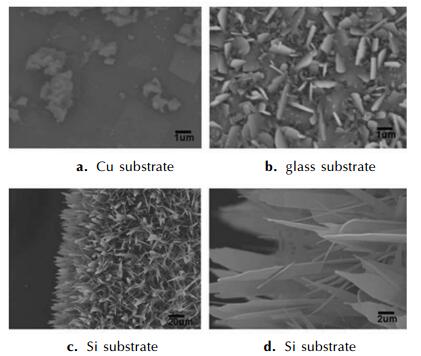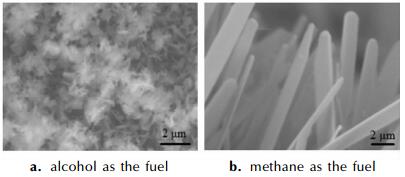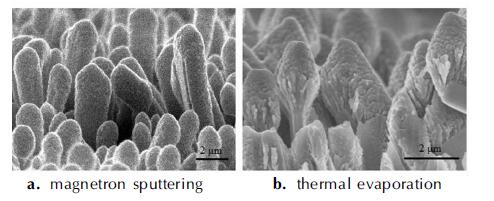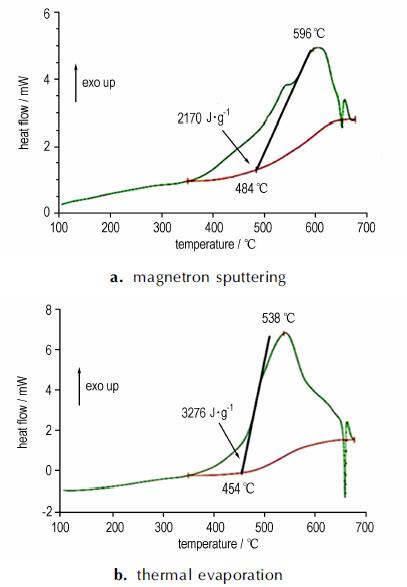2. 中国工程物理研究院化工材料研究所, 四川 绵阳 621900
2. Institute of Chemical Materials, CAEP, Mianyang 621900, China
亚稳态分子间复合物(Metastable Intermolecular Composites, MIC)是近年来出现的一种具有广阔应用前景的新型含能材料, 该复合含能材料不仅具有高的能量密度, 而且由于反应物尺寸达到纳米级, 使得氧化剂(如金属氧化物)和还原剂(主要是纳米铝粉)间的传质距离变短, 传质输运界面面积增大, 从而达到较快的能量释放率[1], 在新型火工品起爆药剂方面有突出的应用前景。MIC的制备方法较多, 其中最常用的方法是物理混合法[2-5]和溶胶胶法[6-10]。这两种方法具有低成本、批量化制备的优点, 有望替代传统起爆药剂。但在集成化火工品起爆药剂方面, 纳米粉体MIC表现出集成工艺复杂、一致性较差的缺陷。
原位集成MIC阵列可以有效克服粉体材料的缺陷, 成为近年来国内外微起爆领域的研究热点。最早Menon L [11]在多孔阳极氧化铝模板中沉积Fe单质, 然后经氧化处理将Fe2O3阵列镶嵌在Al箔中制备了Al/Fe2O3 MIC。MIC阵列要获得实际应用, 还必须获得高能量密度, 以保证在微环境下足够抵消热量损失而保持自持反应。在大量可选择的MIC体系中[12], Al/MoO3可以释放出较多的热量(4705 J·g-1)以及具有较高的绝热温度(3253 K), 成为重点关注的材料[13-16], 目前关于Al/MoO3的报道主要集中在粉体制备与性能, 鲜有Al/MoO3阵列的研究。本实验采用较为简单的火焰法制备了MoO3阵列, 在其上复合纳米Al膜, 研究了Al/MoO3阵列的制备工艺和热性能。
2 实验部分 2.1 试剂与仪器原材料:钼丝(纯度为99.9%), 自贡硬质合金有限责任公司; 铝丝(纯度为99.9%), 石家庄新日锌业有限公司。
仪器及设备:火焰炉(非标); NM2000-T6-SE1磁控溅射系统; Auto 306热蒸发系统; Hitachi TM-1000型扫描电镜(日本); TA Instruments SDT Q20差热示差扫描(美国)。
2.2 制备方法分别将硅片、铜片、玻璃片用酒精及丙酮进行超声清洗, 剪取长为3 cm, 宽为1 cm的长方形条状并依次编号。将3 m的钼丝(直径为0.18 mm)缠绕在长为3 cm, 宽为2 cm的长方形铁架上, 然后放置在炉子火焰的出口处0.5 cm, 将不同的基底放置钼丝网的上方0.5 cm处, 以甲烷为燃料, 点燃燃料, 温度控制在约850 ℃。灼烧时间视实验要求从1 min至7 min不等。图 1为火焰法合成α-MoO3纳米片阵列过程示意图。

|
图 1 火焰法合成α-MoO3纳米片阵列过程示意图 Fig.1 Schematic of the flame synthesis of α-MoO3 nanobelt arrays |
磁控溅射制备纳米Al/MoO3的参数设置为:射频功率60 W, 氩气氛围, 流量为100 sccm, 真空度约为0.1 Pa。真空热蒸发镀铝时的真空度为6.0×10-4 Pa。
DSC测试条件, 在99.999%氮气氛围下, 升温速率为5 ℃·min-1, 温度从20 ℃升到700 ℃。
3 结果与讨论 3.1 基底对MoO3纳米阵列形貌的影响制备MoO3纳米阵列的步骤为:火焰下钼与空气中的氧气反应生成MoO3, MoO3熔点较低, 火焰下变成气态。MoO3气体离开火焰区域后在基底表面沉积形成一定规则形状的MoO3晶体。图 2为生长在不同基底上MoO3的SEM图, 生长时间均为5 min, 所用燃料为甲烷气体。由图 2a可以看出, 在铜基底表面没有生成有序的纳米阵列, 表面颗粒形状不规则。而在玻璃基底上(图 2b), 则有少量的纳米片生成, 但有序性较差, 一部分纳米片倾斜生长于基底, 另一部分则平铺在基底上。在硅基底上, 有大面积的有序纳米片阵列生成, 其结构高度一致, 厚度约100~200 nm, 宽度大约5 μ m(见图 2c和图 2d)。

|
图 2 不同基底所得MoO3纳米阵列的SEM图 Fig.2 SEM images of MoO3 nano arrays with different substrate |
图 3为不同生长时间以硅作为基底, 甲烷为火焰源制备MoO3纳米片的SEM图。当生长时间为1 min时, 生成少量的MoO3纳米片, 且大部分的纳米片都是垂直生长于基底(图 3a)。当生长时间3 min时, 有大量的纳米片生成, 部分垂直于基底, 部分倾斜于基底(图 3b)。当生长时间为5 min时, 纳米片呈现高度有序性, 并垂直于基底生长(图 3c)。当生长时间为7 min时, 可以看到生成的纳米片上, 有少量的较小纳米片生成(图 3d)。可见, 生长时间为5 min时纳米片具有比较整齐的阵列结构。热氧化制备金属氧化物一般经历气相到固相转变过程, 气体分子在已经形成纳米MoO3阵列表面按照晶格取向生长, 当生长到一定程度, 一定空间内纳米片数量增加, 纳米片增大, 相互间接触干扰, 纳米片不能按照晶格取向继续生长, 则会出现支状生长, 不规则程度增加。另外支状生长的纳米片与基底接触不紧密, 容易在后期处理过程中脱落。所以合适的生长时间为5 min。

|
图 3 硅基底上不同生长时间制备的MoO3 SEM图 Fig.3 SEM images of MoO3 on the Si substrate with different growing time |
不同火焰产生不同的温度, 影响气相的流动, 从而影响纳米阵列的形成及形貌。以硅片为基底, 生长时间控制为5 min, 采用不同的火焰源所制备的MoO3纳米片, 其SEM如图 4所示。由图 4a可以看到, 硅基底上生成了具有不规则空间结构的交织网状结构, 并未有纳米片阵列出现。图 4b是制备MoO3纳米片阵列的剖面图, 可以看出, 以甲烷为燃料的火焰源, 生成的MoO3纳米阵列高度有序, 垂直于硅基底上。由此可知, 以甲烷为燃料更有利于MoO3纳米片阵列的生长。

|
图 4 不同的火焰源制备的MoO3 SEM图 Fig.4 SEM images of MoO3 prepared by different flame sources |
采用磁控溅射法和热蒸发法两种不同镀铝方式制备Al/MoO3 MIC, 发现其形貌及放热性能有较明显差别, 结果如图 5所示。由图 5a可以看到, 在沉积纳米铝的过程中, 使用传感器测量沉积纳米铝的厚度, 当镀铝厚度为900 nm时, 纳米Al均匀的粘附在MoO3纳米片外侧形成核-壳结构。与磁控溅射法不同, 由热蒸发法制备Al/MoO3 MIC, 纳米铝则大部分从上方沉积到MoO3纳米片上, 在纳米片的最顶端形成了“小山”的形状(如图 5b所示)。

|
图 5 Al/MoO3 MIC的SEM图 Fig.5 SEM images of Al/MoO3 MIC. |
图 6为采用磁控溅射和热蒸发法所制备Al/MoO3纳米片阵列的DSC曲线。如图 6可知, 二者都有一个放热峰和一个吸热峰,660 ℃附近的吸热峰是未反应完全铝的融化吸热峰。放热峰来自于由铝和三氧化钼反应,磁控溅射法镀铝制备的Al/MoO3 MIC纳米片阵列放热峰为596 ℃(图 6a),而热蒸发法制备产物的放热峰为538 ℃(图 6b), 比磁控溅射法降低了58 ℃。根据DSC结果, 磁控溅射法和热蒸发法镀铝制备的Al/MoO3 MIC纳米片阵列的放热量分别约为2170 J·g-1和3276 J·g-1。所以, 热蒸发法镀铝的放热量更大。这是由于不同制备方法形成的燃料/燃界面会发生界面化学反应, 导致部分燃料反应, 从而影响了总的氧/燃之间的比例。

|
图 6 Al/MoO3 MIC的DSC图 Fig.6 DSC plot of the heat flow for Al/MoO3 MIC |
(1) 采用火焰法制备了MoO3纳米片阵列。其优化生长条件:以硅片为基底, 甲烷为火焰燃料, 生长时间为5 min。
(2) 磁控溅射法和热蒸发法两种方法在MoO3纳米片阵列上沉积纳米铝膜, 均获得了Al/MoO3 MIC纳米阵列。DSC测试结果表明:当热蒸发法镀铝900 nm时制备的Al/MoO3 MIC阵列具有最高的放热量, 为3276 J·g-1。
| [1] |
Umbrajkar S M, Schoenitz M, Dreizin E L. Control of structural refinement and composition in Al-MoO3 nanocomposites prepared by arrested reactive milling[J].
Propellants Explosives Pyrotechnics, 2006, 31(5): 382-389. DOI:10.1002/(ISSN)1521-4087 |
| [2] |
Pantoya M L, Granier J J. Combustion behavior of highly energetic thermites: Nano versus micron composites[J].
Propellants Explosives Pyrotechnics, 2005, 30(1): 53-62. DOI:10.1002/(ISSN)1521-4087 |
| [3] |
Hunt E M, Malcolm S, Pantoya M L, et al. Impact ignition of nano and micron composite energetic materials[J].
International Journal of Impact Engineering, 2009, 36(6): 842-846. DOI:10.1016/j.ijimpeng.2008.11.011 |
| [4] |
Dutro G M, Yetter R A, Risha G A, et al. The effect of stoichiometry on the combustion behavior f a nanoscale Al/MoO3 thermite[J].
Proceedings of the Combustion Institute, 2009, 32(2): 1921-1928. DOI:10.1016/j.proci.2008.07.028 |
| [5] |
Weismiller M R, Malchi J Y, Yetter R A, et al. Dependence of flame propagation on pressure and pressurizing gas for an Al/CuO nanoscale thermite[J].
Proceedings of the Combustion Institute, 2009, 32(2): 1895-1903. DOI:10.1016/j.proci.2008.06.191 |
| [6] |
Prakash A, Mc Cormick A V, Zachariah M R. Aero-Sol-Gel Synthesis of nanoporous iron-oxide particles: A potential oxidizer for nanoenergetic materials[J].
Chemistry of Materials, 2004, 16(8): 1466-1471. DOI:10.1021/cm034740t |
| [7] |
ZHANG Fang, WANG Yan-lan, FU Dong-xiao, et al. In-situ preparation of a porous copper based nano-energetic composite and its electrical ignition properties[J].
Propellants Explosives Pyrotechnics, 2013, 38(1): 41-47. DOI:10.1002/prep.v38.1 |
| [8] |
Kim S H, Zachariah M R. Enhancing the rate of energy release from nanoEnergetic materials by electrostatically enhanced assembly[J].
Advanced Materials, 2004, 16(20): 1821-1825. DOI:10.1002/(ISSN)1521-4095 |
| [9] |
CHEN Ren-jie, LUO Yun-jun, SUN Jie, et al. Preparation and properties of an AP/RDX/SiO2 nanocomposite energetic material by the sol-Gel method[J].
Propellants Explosives Pyrotechnics, 2012, 37(4): 422-426. DOI:10.1002/prep.v37.4 |
| [10] |
Plantier K B, Pantoya M L, Gash A E, et al. Combustion wave speeds of nanocomposite Al/Fe2O3: the effects of Fe2O3 particle synthesis technique[J].
Combustion and Flame, 2005, 140(4): 299-309. DOI:10.1016/j.combustflame.2004.10.009 |
| [11] |
Menon L, Aurongzeb D, Richter C, et al. Size dependence of energetic properties in nanowire-based energetic materials[J].
Journal of Applied Physics, 2006, 100(3): 034317 DOI:10.1063/1.2234551 |
| [12] |
ZHANG Kai-li, Rossi C, Ardila Rodriguez G A, et al. Development of a nano-Al/CuO based energetic material on silicon substrate[J].
Applied Physics Letters, 2007, 91(11): 113117 DOI:10.1063/1.2785132 |
| [13] |
Ilunga K, Del Fabbro O, Yapi L, et al. The effect of Si-Bi2O3 on the ignition of the Al-CuO thermite[J].
Powder Technology, 2011, 205(1/3): 97-102. |
| [14] |
Bockmon B S, Pantoya M L, Son S F, et al. Combustion velocities and propagation mechanisms of metastable interstitial composites[J].
Jourenal of Applied Physics, 2005, 98: 064903 DOI:10.1063/1.2058175 |
| [15] |
Watson K W, Pantoya M L, Levitas V I. Fast reactions with nano-and micrometer aluminum: A study on oxidation versus fluorination[J].
Combustion and Flame, 2008, 155: 619-634. DOI:10.1016/j.combustflame.2008.06.003 |
| [16] |
Asay B W, Son S F, Busse J R, Oschwald D M. Ignition characteristics of metastable intermolecular composites[J].
Propellants Explosives Pyrotechnics, 2004, 29(4): 216-219. DOI:10.1002/(ISSN)1521-4087 |

The highly ordered MoO3 nanobelts array was synthesized by a flame method. The possible factors which may affect the morphology of MoO3 nanobelts, such as different substrate, growing time, and the flame source, were also studied.




